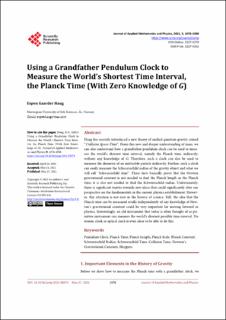| dc.description.abstract | Haug has recently introduced a new theory of unified quantum gravity coined “Collision Space-Time”. From this new and deeper understanding of mass, we can also understand how a grandfather pendulum clock can be used to measure the world’s shortest time interval, namely the Planck time, indirectly, without any knowledge of G. Therefore, such a clock can also be used to measure the diameter of an indivisible particle indirectly. Further, such a clock can easily measure the Schwarzschild radius of the gravity object and what we will call “Schwarzschild time”. These facts basically prove that the Newton gravitational constant is not needed to find the Planck length or the Planck time; it is also not needed to find the Schwarzschild radius. Unfortunately, there is significant inertia towards new ideas that could significantly alter our perspective on the fundamentals in the current physics establishment. However, this situation is not new in the history of science. Still, the idea that the Planck time can be measured totally independently of any knowledge of Newton’s gravitational constant could be very important for moving forward in physics. Interestingly, an old instrument that today is often thought of as primitive instrument can measure the world’s shortest possible time interval. No atomic clock or optical clock is even close to be able to do this. | |
